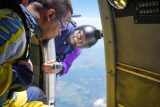How Much Does Skydiving Cost?
Tandem Skydiving
Posted by: SKYDIVINGDOTCOM 2 years ago
The cost of skydiving is top of mind for everyone interested in taking flight, and especially those who have yet to make their first tandem skydive and aren’t sure what to expect. While skydiving dropzones establish their own pricing matrix, there are common elements that factor into the overhead at every DZ that affect prices.
Here we’ll get into the average cost of skydiving in the US, check out some of the expenses DZs consider, and discuss why skydiving should be expensive!
How Much Is Skydiving?
The price to go skydiving varies, sometimes dramatically, depending on where you go and what services you choose.
In the US, you can expect tandem skydiving prices to fall in the vicinity of $200 USD. Some dropzones charge a little less, and others charge closer to $300 USD. Some services come at a premium, like choosing a beach landing over an airport landing, skydiving at sunrise or at sunset, or jumping on the weekend when demand is high versus during the week.

If you poke around dropzone websites, you’ll frequently find discounts on offer. Skydiving specials are pretty standard for students, groups, and the military. Some dropzones offer reduced pricing for various reasons too – those who book their second jump immediately after their first is a common example, or jumping on your birthday is another. Read pricing pages carefully, check out a DZ’s social media, or give them a call to learn about potential discounts.
What Drives Skydiving Prices?
There are numerous expenses associated with the cost of skydiving, including:
- Fuel
- Aircraft
- Equipment
- Maintenance
- Personnel
- Location
- Offerings
Fuel
Aircraft use special fuel, all of which is – of course – expensive! Jet A fuel (also known as Jet A-1 or JP-1A) is civil aviation’s international choice for turbine engines and is commonly seen in tankers on airports. The other frequently used fuel is AvGas (also known as aviation gasoline or aviation spirit), which is used for aircraft with spark-ignited, internal combustion engines. In the future, we may have the option to use biokerosene … but not yet.
Aircraft
The type of aircraft a dropzone chooses to use impacts overhead too. The most commonly seen aircraft in the skydiving industry is the Cessna 182. It’s a small but mighty, and relatively affordable, workhorse – but it’s not especially fast and it can hold only four skydivers. More powerful planes, like the Cessna Caravan, Twin Otter and King Air, or the coveted Skyvan, PAC or Pilatus Porter, get to altitude faster, hold more people, and also cost more to run.

Equipment
Safely and responsibly skydiving requires sophisticated gear and equipment. Every tandem skydiving rig includes a main parachute and reserve parachute, as well as an automatic activation device (AAD). An AAD deploys the parachute in the event the instructor cannot. Prices associated with this mandatory skydiving gear and equipment are high (probably a lot higher than you’d think!), and prices tend to go up annually.
Maintenance
The skydiving industry is highly regulated. In the US, the Federal Aviation Administration (FAA) has jurisdiction over the industry, and the United States Parachute Association (USPA) both advocates for and oversees the sport, including enforcement of FAA and USPA rules – all of which are stringent. Aircraft and gear must be meticulously maintained and regularly inspected. As an example, reserve parachutes are repacked every 180 days, regardless of their use.
Personnel
Skydiving dropzones employ ground and sky crew, all of whom are highly trained. Numerous team members are also required to be experienced and credentialed, such as the pilots, skydiving instructors, tandem instructors, and videographers. Maintaining safety and customer service standards of the highest caliber requires that DZs hire – and keep – the best of the best. Investing in top-notch team members is good for business and serves to advance the sport.

Location
Know the adage “location, location, location”?! It applies to dropzones as well. While a skydiving dropzone in a postcard-perfect locale can charge a premium just for the augmented customer experience, it’s important to remember that running a business in these locations can come at a hefty price to the DZ too. Everything costs more in a tourist destination, especially when the area is subject to seasonal population surges.
Offerings
Some dropzones have amazing bells and whistles on offer. Higher altitude (with supplementary oxygen), awesome media packages (first timers should always get the video), and combo packages, like an indoor and outdoor skydiving experience, or a skydive and aerobatics experience. Some DZs even offer opportunities to jump from multiple aircraft, such as helicopters, hot air balloons, and elite planes. If it tickles your fancy, go for it!

Skydiving Should Be Expensive!
Now that you have a sense of some of the expenses involved in running a skydiving dropzone, you can understand why skydiving is expensive!
Skydiving dropzones that offer deep discounts and bargain basement pricing should be subject to scrutiny before booking. Low prices likely mean cut corners – and when shortcuts are taken with an extreme sport like skydiving, the end result may be danger or even disaster.
Before choosing a skydiving dropzone, regardless of pricing, you must do your homework. Google the dropzone, spend time with their reviews, call the DZ directly to get a sense of the professionalism and vibe, and, if possible, visit the facility. Don’t hesitate to ask questions. A compliant dropzone will proudly answer them all!
—
Ready to find that “skydiving dropzone near me”? Check out our DZ locator to see which DZ suits your needs, goals, and price point. Blue skies!
DZ Locator
Find a skydiving center near you.



